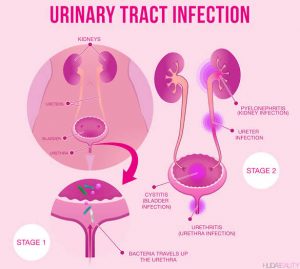Contents:
Urinary tract infection (UTI): Symptoms, Cause, Types and Treatment
Introduction
- (UTI) or urinary tract infection is an infection caused by microbes.
- These are microscopic organisms that cannot be seen through naked eyes.
- Most of it is caused by bacteria but some are caused by fungi and rarely caused by viruses.

- UTIs are the most common infections in homo sapiens.
- A UTI can happen anywhere from starting kidney to bladder following to ureters, the urinary tract is made up of kidneys, ureters, bladder, and urethra.
- Most of it only involves the urethra and bladder, in the lower part of the urinary tract.
- However, UTIs can also involve the upper tract it including ureters and kidneys.
- The upper tract UTIs are very rare than lower tract UTIs, they’re also usually more severe.
- women are more chance of getting a urinary tract infection.
- Experts ranked lifetime risk of getting single as high as 1 in 2, with many women having repeat infections, sometimes for years.
- In men, the number to less as 1 in 10 will get a UTI in their lifetime.
SYMPTOMS OF UTI’s
- The symptoms of a Urinary tract infection can include:
- A burning feeling during urination.
- A frequent urge for urination, even though little comes out when you pee.
- Foamy, dark, bloody, or strange-smelling in urination.
- Fever or chills (a sign that the infection may have reached your kidneys)
- Pain or pressure in your lower back belly region or lower abdomen.
DIAGNOSIS
- Diagnosis of urinary tract infection can be done through the normal urine routine test.
- It also involves the culture of a urine sample for 48 to 72hr under favourable condition.
TYPES OF UTI’s
- A urinary tract infection can happen in different parts of your urinary system. Each type has subject as a different name, based on their location.
- Cystitis (bladder): urge to pee a lot or feel like need to pee immediately, or it might hurt during urination.
- You might also have lower belly pain and foamy or bloody urine.
- Pyelonephritis (kidneys): This causes fever, chills, vomiting, nausea and pain in your upper back or side.
- Urethritis (urethra): This causes discharge and burning when you urinate.
- UTIs are usually caused by bacteria from poo entering the urinary tract.
- The bacteria enter into the through a tube that carries urine out from the body (urethra).
- Women have a short urethra than men. This means bacteria are more likely to reach the bladder or kidneys and cause an infection.

CAUSES OF UTIS INCLUDE
- UTI also caused during pregnancy.
- conditions that block the urinary tract – such as kidney stones.
- In these conditions, it’s very difficult to fully empty the bladder such as an enlarged prostate gland in men and constipation in infants.
- It also caused by urinary catheters (it is a tube in your bladder used for passage urine)
- Also caused by having a weakened immune system, as an example type 2 diabetes, chemotherapy or HIV.
TREATMENT
- the first-line treatment for urinary tract infections are antibiotics these are the class of drugs which are prescribed and for how long depend on your health condition and the type of bacteria found in your urine.
SIMPLE INFECTION
- The common drugs recommended for simple UTIs include:
- Trimethoprim/sulfamethoxazole (Bactrim, Septra, others)
- Nitrofurantoin (Macrodantin, Macrobid)
- Fosfomycin (Monurol)
- Cephalexin (Keflex)
- Ceftriaxone
- The class of antibiotic medicines called fluoroquinolones such as ciprofloxacin (Cipro).
- levofloxacin (Levaquin) and others are not commonly recommended for simple UTIs.
- The risks of these medicines generally out weigh the benefits of treating uncomplicated UTIs.
- In rare cases, such as a complicated UTI or kidney infection, the doctor may prescribe a fluoroquinolone medicine if no other treatment options exist.
- Often, symptoms clear up within a few days of treatment.
- But you may need to continue antibiotics for a week or more. Take the entire course of antibiotics as prescribed.
REFERENCE
- https://www.ncbi.nlm.nih.gov/pmc/articles/PMC4457377/
- https://www.ncbi.nlm.nih.gov/pmc/articles/PMC2875701/
- https://www.ncbi.nlm.nih.gov/pmc/articles/PMC5159206/